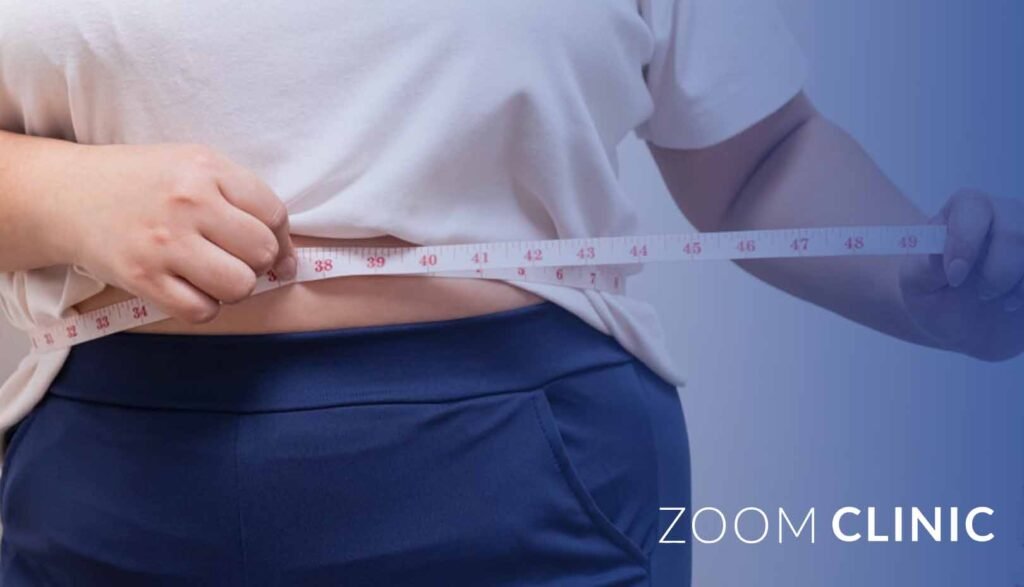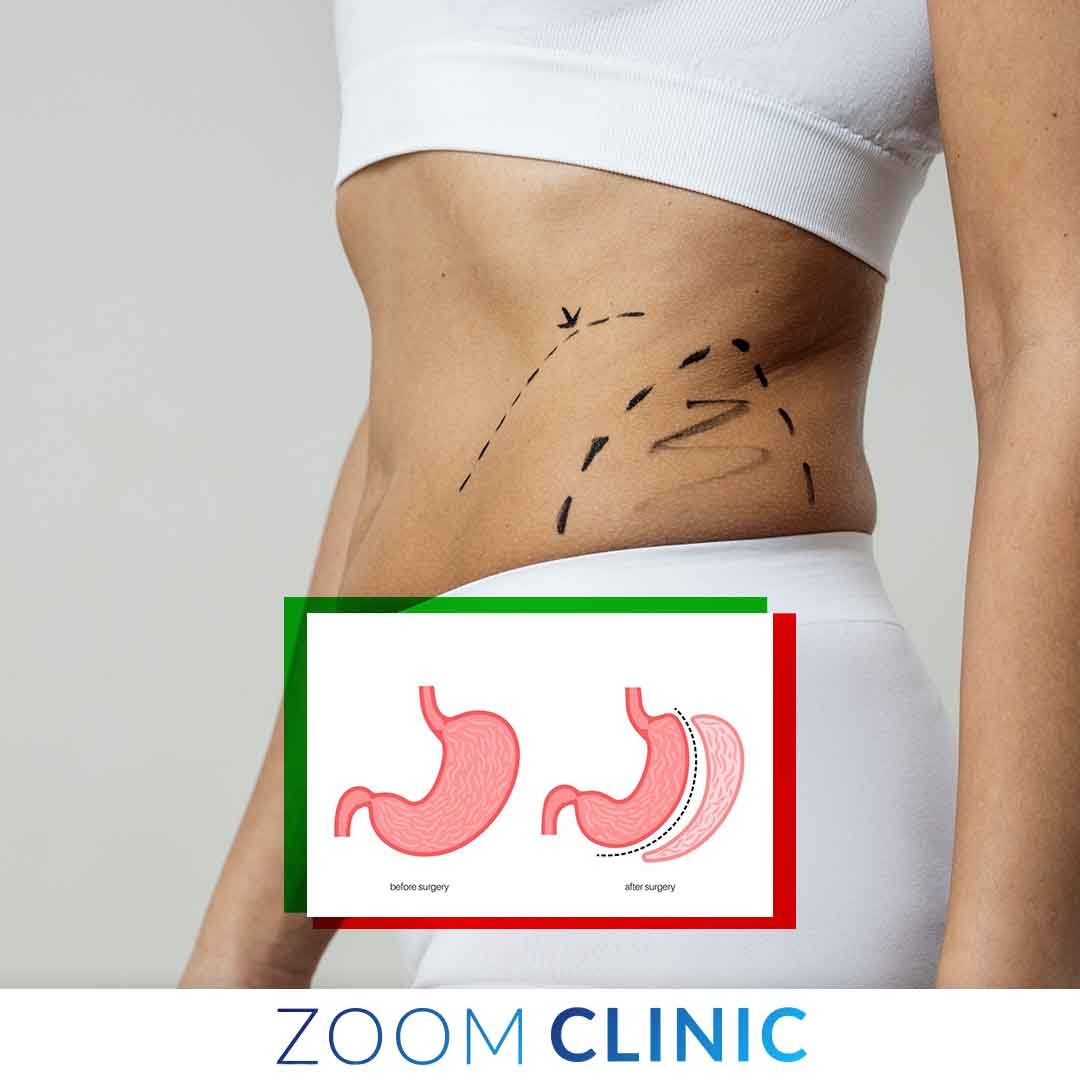Sleeve gastrectomy is a popular weight loss surgery that has helped millions of people achieve their weight loss goals. However, it’s important to understand the changes your body, particularly your abdominal area, will undergo after the procedure. For many patients, the journey doesn’t end with surgery; it is the beginning of a series of physical changes, especially in the abdomen. In this comprehensive guide, we’ll walk you through the Abdominal Changes After Sleeve Gastrectomy and how to manage them effectively.
Zoom Clinic, with over 10 years of experience, has helped many patients through their transformations, and we are here to help you navigate your own journey.
Table of Content
1. Understanding Sleeve Gastrectomy and Its Impact on Your Abdomen
What is Sleeve Gastrectomy?
Sleeve gastrectomy is a form of bariatric surgery where approximately 80% of the stomach is removed, leaving a small, banana-shaped section. This new, smaller stomach restricts food intake and helps induce weight loss by altering hunger-related hormones, such as ghrelin.
Expected Changes in the Abdominal Area After Surgery
The surgical alteration of the stomach is just the beginning of your journey. As you lose weight rapidly after sleeve gastrectomy, your body, especially your abdominal area, will undergo significant changes. From skin laxity to changes in muscle tone, these transformations are natural as your body adjusts to a reduced stomach size and massive weight loss.
The Role of Reduced Stomach Size in Physical Changes
With a smaller stomach, food intake is drastically reduced, which kickstarts rapid weight loss. This reduction leads to changes in the skin and muscles in your abdominal area, which may include the appearance of excess skin or alterations in muscle tone. Understanding these changes helps set realistic expectations for your post-surgery journey.
2. Immediate Post-Operative Abdominal Changes

Swelling and Bruising: Normal Response to Surgery
Immediately following surgery, you will likely experience some swelling and bruising in your abdominal area. These are normal side effects of the surgical process and indicate the body’s natural healing response. Swelling typically peaks within a few days after surgery and gradually subsides over the next few weeks.
Incision Healing Process
The procedure involves small incisions made in the abdominal wall, through which the surgery is performed. You will need to take care of these incisions to ensure proper healing. Keeping the incisions clean and dry, and avoiding strenuous activity, are crucial steps to avoid complications such as infection.
Expected Discomfort and Pain Levels
You will experience some degree of discomfort or pain following the surgery, especially around the incision sites. The pain is usually manageable with prescribed medications. As the healing process progresses, the pain should gradually subside, but you may feel occasional tightness or pulling as your body adjusts to its new anatomy.
3. How Your Abdomen Changes in the Short Term
The Body’s Natural Response to Rapid Weight Loss
Once you start losing weight, you may notice changes in the shape and texture of your abdominal area. The body undergoes several adjustments as it sheds excess fat, which can include the development of loose skin. This is largely because the skin’s elasticity is often unable to keep up with the rate at which you are losing weight.
Skin Elasticity and the Onset of Loose Skin
As the fat layer beneath the skin reduces, the skin itself can begin to sag. This is especially evident in the abdominal area, which holds a significant amount of body fat. The extent of loose skin varies from person to person and depends on factors such as age, genetics, skin elasticity, and the amount of weight lost.
Common Sensations Like Tightness or Pulling as the Body Adjusts
As your body adapts to the changes, you might feel sensations of tightness or pulling in your abdomen. These sensations are usually harmless and indicate the adjustment period as the muscles and skin in the area accommodate the new body size.
4. Long-Term Abdominal Changes

Excess Skin and Its Causes
After significant weight loss, it is common to have excess skin around the abdomen. This happens because the skin stretches to accommodate excess fat, and when that fat is rapidly lost, the skin may not have the elasticity to shrink back to its original size.
Stages of Weight Loss and How the Abdomen Reacts
In the months following your sleeve gastrectomy, your weight loss will likely be most rapid in the first six months, and then it will slow down. During this time, your abdomen will gradually adapt to these changes, but loose skin may still be prominent, particularly if you have lost a large amount of weight.
Variability in Skin Retraction – Factors That Influence It
Not everyone experiences the same degree of loose skin. Factors that influence skin retraction include age (younger skin tends to be more elastic), genetics, hydration levels, and overall skin health. Exercise and proper nutrition can help improve the appearance of loose skin, but it may not completely eliminate it.
5. Managing Loose Skin Post-Sleeve Gastrectomy
Non-Surgical Approaches: Exercise, Diet, and Hydration
To manage loose skin, it’s important to incorporate physical activity that helps tone the abdominal muscles. Core exercises, including planks and crunches, can help firm up the abdominal area, making the loose skin less noticeable. Additionally, a balanced diet rich in protein, vitamins, and minerals supports skin health, and staying well-hydrated helps maintain skin elasticity.
The Role of Collagen and Skin Care Routines
Collagen is a key protein that provides structure to the skin. Taking collagen supplements or eating collagen-boosting foods, such as bone broth or vitamin C-rich fruits, can support skin health. Topical treatments like firming creams containing retinoids or hyaluronic acid can also help, though their effects may be subtle compared to surgical interventions.
Surgical Options Like a Tummy Tuck for Those Who Need It
For those dealing with significant excess skin that affects quality of life, surgery may be the most effective option. An abdominoplasty, or tummy tuck, removes excess skin and tightens the abdominal muscles to create a more contoured appearance. Consult with Zoom Clinic experts to determine if this is a suitable option for you.
6. Nutrition and Its Role in Abdominal Changes

How Proper Diet Aids in Minimizing Loose Skin
A well-balanced diet post-surgery not only aids in weight loss but also supports your skin’s ability to adapt. Eating lean protein helps build muscle and repair tissues, while antioxidant-rich fruits and vegetables provide nutrients that help maintain healthy, elastic skin.
Key Nutrients That Support Skin Elasticity
Vitamin C is vital for collagen production, and foods rich in omega-3 fatty acids, like salmon and walnuts, help maintain skin elasticity. Zinc is another mineral that aids in tissue repair, which is crucial for post-operative recovery.
Hydration and Its Importance
Hydration is key to skin health. Drinking plenty of water helps maintain skin elasticity and ensures that your skin remains plump and supple, even during rapid weight loss.
7. Exercise: Strengthening and Toning Your Abdomen
Best Exercises for Abdominal Toning Post-Surgery
After you have healed sufficiently, exercise plays a crucial role in toning the abdominal area. Activities like walking, swimming, and cycling are excellent for cardiovascular health and support gradual weight loss. Once your doctor gives the go-ahead, you can include abdominal-focused exercises like planks and leg raises to help tone the core.
The Importance of Core Strengthening
Strengthening the core is important not only for aesthetic reasons but also for your overall posture and balance. A strong core can reduce the likelihood of back pain, which is a common complaint among individuals who have undergone rapid weight changes.
Recommended Timelines for Starting Exercise After Surgery
Typically, you can start light physical activity, like walking, a few weeks after surgery. More intense exercises, including core work, are generally recommended after 6-8 weeks, depending on how well you are healing. Always follow your surgeon’s advice before beginning any exercise program.
8. Scarring and Its Impact on Abdominal Appearance

What to Expect Regarding Scar Healing
The small incisions made during sleeve gastrectomy will leave scars. Initially, these scars may be red or pink, but they should fade over time. Proper care, such as keeping the scars clean and using prescribed creams, will help in the healing process.
Tips for Minimizing Scars Over Time
Scar creams and silicone sheets can be used to reduce the appearance of scars. Protecting the area from sun exposure by using sunscreen or covering it will prevent the scars from becoming more pronounced. Massaging the scar tissue can also help break down the fibrous tissue, making scars less visible.
Treatments for Scar Reduction
For those who are concerned about the appearance of their scars, treatments like laser therapy, micro-needling, or steroid injections can be considered. Zoom Clinic offers several options to help minimize the appearance of surgical scars.
9. Emotional and Psychological Aspects of Abdominal Changes
Body Image Changes and Emotional Adaptation
Rapid changes in your body can lead to mixed emotions. While losing weight can bring feelings of happiness and accomplishment, adjusting to excess skin or scars can be challenging. It’s important to acknowledge these feelings as a natural part of your journey.
Coping Strategies for Dealing With Excess Skin
Joining a support group, either in-person or online, can provide a valuable source of encouragement from people who are experiencing similar changes. Additionally, talking to a mental health professional can help you develop coping strategies and address any concerns related to your new body image.
The Importance of Setting Realistic Expectations
Realistic expectations are key to feeling satisfied with your sleeve gastrectomy results. Loose skin is a natural part of the process for many, and understanding that it may not fully retract can help you appreciate the positive health changes that the surgery has brought to your life.
10. How Zoom Clinic Supports You After Sleeve Gastrectomy
Comprehensive Post-Operative Care
Zoom Clinic provides comprehensive post-operative care that includes regular follow-ups, nutritional guidance, and exercise recommendations tailored to your needs. Our experienced medical professionals are committed to supporting you at every step of your journey.
Personalized Plans for Managing Abdominal Changes
We understand that each patient is unique, and so are their bodies. Zoom Clinic offers personalized plans that take into account your specific needs, ensuring that you achieve the best possible results in managing your abdominal changes after surgery.
Testimonials From Patients on Their Post-Surgery Transformations
Many of our patients have successfully navigated the changes after sleeve gastrectomy and are now living healthier, happier lives. Their experiences highlight the importance of expert care, determination, and a positive attitude throughout the journey.
11. Frequently Asked Questions
Will My Abdomen Return to Normal After Weight Loss? The abdomen will change significantly, but loose skin may be present for some patients, depending on various factors such as age, genetics, and the amount of weight lost.
How Long Before I See the Final Results of My Abdominal Changes? It typically takes about 12 to 18 months post-surgery for the body to stabilize, and for you to see the final results of weight loss and how the skin has adapted.
Can I Prevent Loose Skin Altogether? It’s challenging to prevent loose skin completely, especially with significant weight loss. However, staying hydrated, exercising, and taking care of your skin can help improve its appearance.
Conclusion
Sleeve gastrectomy is a life-changing procedure that brings numerous health benefits, but it’s also important to be prepared for the physical changes, particularly in the abdominal area, that come after surgery. Understanding these changes, maintaining a proper diet, exercising, and utilizing the right skin care strategies can help you manage them effectively.
Zoom Clinic, with over a decade of experience, is committed to helping you through this journey, offering the support and care you need every step of the way. Your transformation is not just about weight loss—it’s about embracing a healthier, happier you.
Get the special offer today from Zoom Clinic
Read Also:
The Appropriate Ages for Gastric Sleeve Surgery


